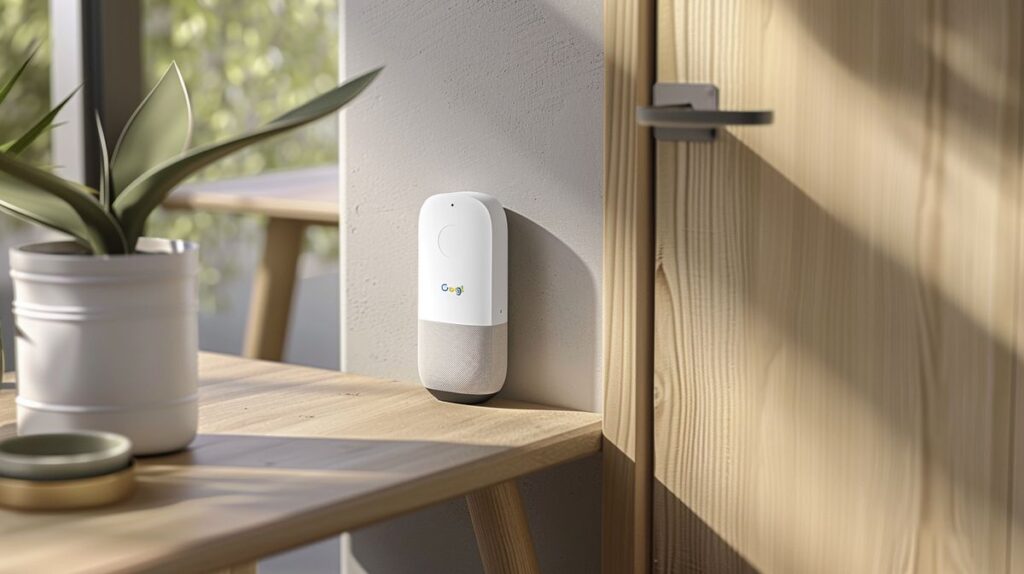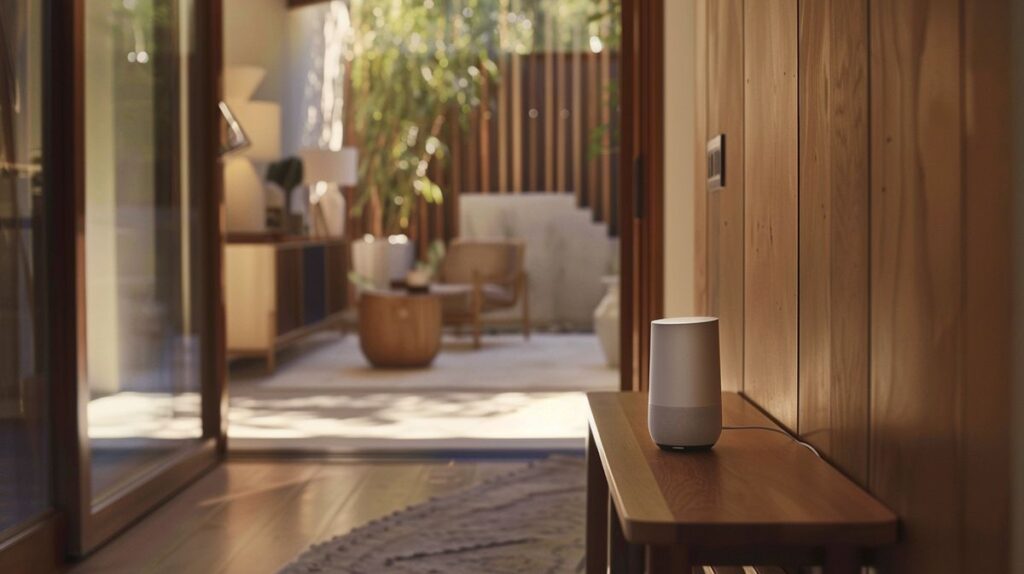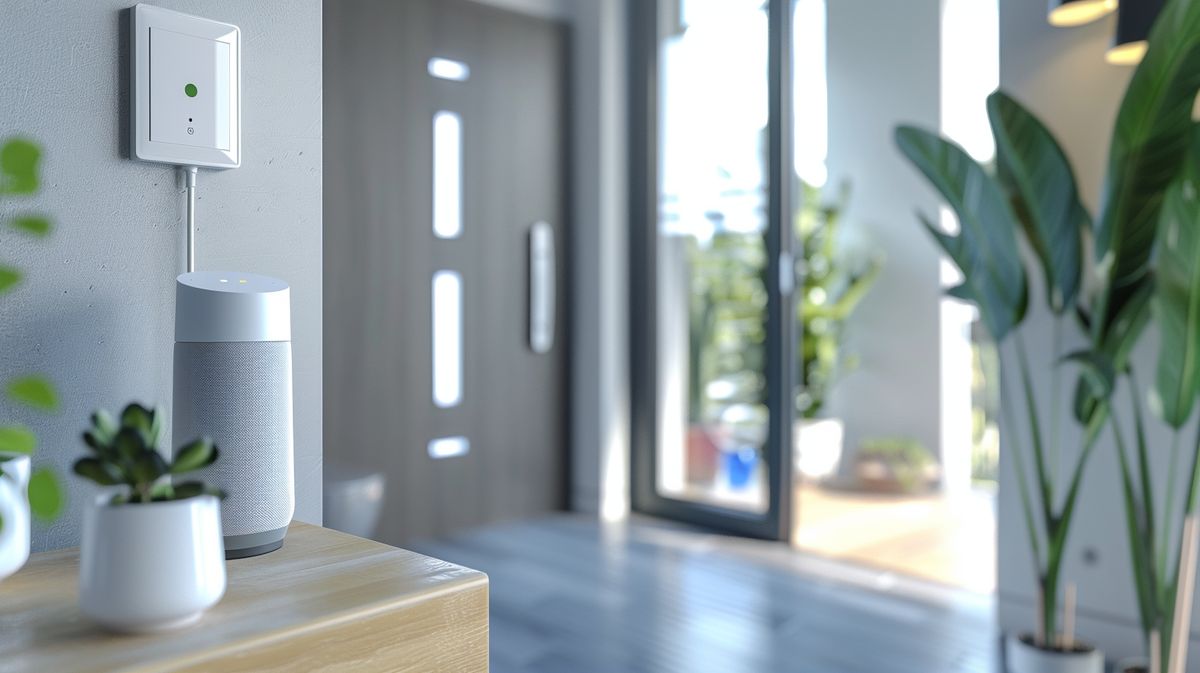Best Door Sensors That Work with Google Home for Top Security
Ever wondered how you can boost your home security to new heights in 2024? Allow me, James Albright, home security expert, to let you in on a transformative modern innovation: Door Sensors That Work with Google Home.
This isn’t just tech talk; it’s your peace of mind at stake. These advanced sensors integrate seamlessly with Google Home, ensuring that you’re kept in the loop about any security breaches in real-time, right from your smartphone. No more worrying about whether you forgot to lock the back door.
This article will shed light on the best door sensors compatible with Google Home, showing you how to arm your home with an unparalleled level of security and convenience. Intrigued? Buckle up and let’s get started.
Introduction to Door Sensors and Google Home Integration
Overview of Door Sensors
Door sensors are a cornerstone of any smart home security system. These small devices detect if doors or windows are opened or closed, adding an essential layer of safety. Consider them your home’s first line of defense.
- Enhanced Security: Every time a door or window is tampered with, you’ll receive an alert. It’s like having a vigilant guard at every entry point.
- Hub Requirements: Most smart door sensors need a hub or bridge to connect to Google Home, but some offer direct integration via built-in Wi-Fi, making them more convenient.
- Real-Time Notifications: Effective door sensors provide instant notifications, giving you peace of mind whenever a door or window is opened or closed.
- Battery Longevity: Battery life can range from several months to years, depending on usage and the specific model. Keeping an eye on battery levels ensures continuous protection.
Explanation of Google Home
Google Home serves as the control center for all your smart devices, including door sensors. It streamlines the management and monitoring of your home’s security with ease.
- Centralized Hub: Google Home integrates seamlessly with door sensors, letting you receive alerts, create automated routines, and manage devices via voice commands.
- Voice Commands: Use Google Assistant to check the status of your door sensors with simple voice queries. It’s as easy as asking a friend.
-
Platform Compatibility: Many door sensors are designed to work across multiple platforms like Google Home, Apple HomeKit, Alexa, and SmartThings, making them highly versatile.
In this video, discover why the Aqara Contact Sensor is recommended as the top choice for door sensors compatible with Google Home. Learn about its impressive battery life, accuracy, and how it integrates smoothly with your smart home setup.
Benefits of Using Door Sensors with Google Home
Imagine having an invisible guard watching your doors 24/7. Integrating door sensors with Google Home transforms this from a dream into a reality. Let’s delve into how these sensors bolster your home’s security and convenience.
Enhanced Security and Monitoring
- Nothing beats the peace of mind knowing your home is secure. Reliable door sensors within your Google Home ecosystem boost security, providing real-time alerts for any door activity.
In this video, learn how contact sensors operate and how to integrate them with Google Home via Home Assistant to enhance your home security and automation setup.
It’s like having a vigilant watchdog. - Picture this: A door opens, and instantly, the lights turn on or security cameras activate, ensuring your home is protected with a reliable system. For more information on choosing the right home security system tailored to your needs, check out this guide on the best home security systems from CNET when choosing a home security system for your home. These sensors seamlessly integrate into your smart routines, adding an extra layer of safety.
- Combine door sensors with alarms and cameras, and you’ve got a fortress. A comprehensive setup ensures efficient monitoring of every aspect of your home.
Automation Features
- You want a smart home, but do you have a truly connected one? Door sensors can trigger other devices, making your home not just smart but intuitive.
- For instance, you could set a routine where an open door sends an alert to your smartphone or activates smart lights. This kind of automation makes your life smoother and more secure.

Voice-Activated Control
- Ever wondered if you left the door open? With Google Home, simply ask, “Hey Google, is the front door open?” and get an immediate response. Door sensors integrated with Google Home bring convenience right to your voice.
Join James as he explores top security systems that work seamlessly with Google Home, including door sensors like those from Nest and Simply Safe. Discover how these systems enhance your smart home security and provide convenient voice control features. - Beyond just checking status, you can manage other devices linked to your door sensors with voice commands. This makes your smart home experience incredibly hands-free and efficient.
Remote Access and Notifications
- Google Home integration lets you receive real-time alerts and handle door sensors with voice commands. It’s like having a security control room in your pocket.
- Modern life requires flexibility. An effective mobile app allows remote access to control and monitor your door sensors, keeping you informed and in charge, no matter where you are.
- Remember to regularly test your door sensors to ensure everything runs smoothly. This practice guarantees that your home security system is always at its best, providing much-needed peace of mind.
Choosing the Best Door Sensors That Work with Google Home
When you’re picking out door sensors that work with Google Home, there are a few things you need to consider to make sure they fit your smart home setup perfectly. Let’s dive into the details to help you make an informed decision.
Compatibility and Integration
- Ensure the door sensors are compatible with Google Assistant or Google Home. This provides seamless integration and lets you control everything through your Google Home app.
- Verify support for communication protocols like Zigbee, Z-Wave, or Matter. These ensure reliable connectivity and integration across different smart home devices.
Installation Process
- Choose sensors with easy installation features. Look for models with adhesive strips or screws for straightforward and hassle-free mounting.
- During installation, make sure the sensor and its magnet are well-aligned. This reduces false alerts and ensures consistent performance.
- Carefully follow the installation guide to pair the sensor with Google Home correctly. Proper pairing is essential for optimal function.
Battery Life and Design Considerations
- Opt for sensors with long battery life to minimize replacement frequency. Some can last years on a single battery, saving both time and money.
- Consider compact, aesthetically pleasing designs. Discreet models blend seamlessly with your home decor, not standing out or detracting from the room’s appearance.
Key Features to Look For
- Check if the sensor allows for automation and routine setups with Google Home. Features like smartphone alerts or triggering other smart devices when a door opens can enhance your smart home ecosystem.
- Evaluate the sensor’s range, specifically the maximum gap between the sensor and its magnet. A greater range provides more flexibility and accommodates different door types and setups.
- Ensure robust security and privacy features. Look for strong data encryption and minimal data sharing. Avoid models with built-in cameras or microphones unless necessary for your use case.
Pros and Cons of Different Sensors
- Compare the benefits and drawbacks of various door sensors. Focus on their compatibility with Google Home, ease of use, and integration capabilities.
- Assess models by considering installation simplicity, user experience, and reliability of integration with Google Home.
- Be aware of potential challenges like the need for Wi-Fi, occasional disconnections, and compatibility issues. Understanding these helps in selecting the right sensor for your setup.
Installing and Setting Up Door Sensors That Work with Google Home
Step-by-Step Installation Guide
- First things first: opt for door sensors that are easy to install. Models with adhesive strips or screws make the setup hassle-free, even for folks without technical know-how. It’s like using double-sided tape—just stick and go!
- Make sure the sensor and the magnet are perfectly aligned during installation. A little misalignment can cause false alerts or missed detections. Think of it as matching up a zipper—both sides need to align perfectly to work right.
Pairing with Google Home
- Open the Google Home app on your phone to start pairing your door sensors. Hit the ‘Add’ option to include a new device and follow the in-app instructions. It’s like adding a new contact to your phone—just a few clicks, and you’re done.
- Ensure both the door sensors and your Google Home are on the same Wi-Fi network. Consistency is key here. Imagine trying to have a conversation on a different phone plan—it just wouldn’t work as smoothly.
Configuring Settings and Automation
- With Google Home, you can set up custom automation routines. Want a notification on your phone when someone opens a door? You got it. Or, maybe you want to trigger other smart devices. It’s like setting up your coffee maker to start brewing right when you wake up—simple and efficient.
- Google Assistant integration lets you control your door sensors with voice commands. Check the status of your doors and windows or activate specific routines, all by saying a few words. It’s as convenient as asking a friend if the door is locked.
Troubleshooting Common Issues
- Running into problems connecting your door sensors to Google Home? Manufacturer troubleshooting guides are your best friend. Common issues often revolve around network connectivity or compatibility, so recheck your settings or restart your devices. For more advanced home automation solutions, consider exploring door sensors that work with Alexa to enhance your smart home experience. It’s like rebooting your computer to fix a glitch.
- For everything to work smoothly, make sure every device is on the same network and fully compatible with Google Home. It’s like ensuring all your instruments are tuned to the same key in a band—it just makes the performance smoother.
Maintenance and Updates for Door Sensors
Ensuring your door sensors work seamlessly with Google Home is vital for comprehensive home security. This section covers essential maintenance tasks that keep your sensors in top shape, offering practical tips for software updates, regular monitoring, and battery maintenance.
Regular Software Updates
- Keep Sensors Updated: Regular firmware updates are like doctor visits for your door sensors. They fix bugs, enhance security, and add new features, ensuring compatibility with Google Home.
- Optimize Performance: Manufacturers release updates to improve battery life and detection capabilities. Staying updated ensures your sensors perform optimally and securely.
Monitoring and Testing the Sensors
- Regular Testing: Checking your door sensors every few months is crucial. It’s like giving them a periodic health check-up to prevent false alarms and missed notifications.
- Customer Feedback: Before choosing a sensor, consider ratings and reviews from other users. Their experiences provide valuable insights into the long-term reliability of sensors compatible with Google Home.
Battery Replacement and Maintenance Tips
- Choose Long-lasting Batteries: Opt for sensors with extended battery life to minimize replacements. Some last months or even years, reducing the hassle of frequent maintenance.
- Proper Placement: Follow the manufacturer’s guidelines to extend sensor life. Place them away from extreme temperatures and keep them clean and unobstructed to ensure proper functionality.
Popular Door Sensors That Work with Google Home
Nest Door Sensors
- If you want a door sensor that blends seamlessly with your Google Home system, Nest should be high on your list. These sensors offer top-notch integration for a smooth and efficient user experience.
- With their solid build quality and reliable performance, Nest door sensors are favored by many. Add robust customer support into the mix, and it’s clear why they’re a popular choice.
Samsung SmartThings Sensors
- Samsung SmartThings Sensors shine when it comes to compatibility with a wide range of smart home ecosystems, especially Google Home. They are versatile and adaptable.
- The flexibility in automation and integration options makes these sensors a valuable addition to any smart home setup, enhancing your overall home security system.
Sengled Door Sensors
- Looking for simplicity? Sengled door sensors offer a straightforward installation process and hassle-free integration with Google Home.
- They come with an impressive battery life and a user-friendly interface that ensures a smooth and efficient user experience.

Philips Door Sensors
- Durability and dependability are the hallmarks of Philips door sensors. They work efficiently within Google Home systems.
- When integrated with other Philips smart products, these sensors enhance your smart home ecosystem, providing a cohesive experience.
Other Noteworthy Brands
- Besides the big names, brands like Ecolink, Visonic, and Aeotec are well-regarded for their robust design and consistent performance.
- These brands offer a variety of options that cater to different needs and budgets, expanding your choices for reliable door sensors that work with Google Home.
Cost Considerations for Door Sensors Compatible with Google Home
Choosing the right door sensor that integrates seamlessly with Google Home isn’t just about comparing prices. It’s about balancing your budget with the features you need, ensuring your choice provides both security and value.
Price Range and Features
- The cost of door sensors that work with Google Home can vary significantly. You can find budget-friendly models perfect for those just starting with smart home technology, and high-end sensors packed with advanced features for a more polished experience.
- Key features affecting the price include battery life, detection range, and overall design. Think of higher-priced models as the premium seats at a concert—they often provide extended battery life, broader detection ranges, and aesthetic designs that blend seamlessly with your home decor.
- When choosing a door sensor, seriously evaluate the cost-to-benefit ratio. How much are you willing to invest for the functionalities that best suit your smart home setup?
Budget-Friendly Options
- For those on a budget, brands like Sengled and certain models from Samsung SmartThings offer affordable solutions without sacrificing key features. It’s like getting the best seats at that concert without breaking the bank!
- These budget-friendly options generally cost less than $50, making them ideal for newcomers to smart home technology or those looking to expand their existing setups economically.
High-End Models and Their Benefits
- Premium models from brands like Nest and Philips are the luxury cars of door sensors—equipped with advanced features such as superior design aesthetics, extended battery life, and enhanced integration capabilities with Google Home.
- While these high-end models come with a steeper price tag, they offer robust and reliable performance. This makes them a worthwhile investment for anyone looking for a comprehensive and seamless smart home experience.
Future Trends in Door Sensors for Google Home
Advancements in Sensor Technology
Imagine never having to worry about constantly changing the batteries in your door sensors. That’s where we’re headed with future door sensors—longer battery life and improved power management ensure your home remains protected without frequent interruptions. Think of it as upgrading from disposable batteries to a solar-powered lantern. Relief, right?
Another game-changer is the adoption of new communication protocols like Matter. Envision a seamless smart home experience where your Google Home syncs effortlessly with door sensors from various brands. A bit like ensuring all your smart gadgets speak the same language, making your smart home network more harmonious and less of a tech headache.
Lastly, we’re looking at enhanced detection capabilities. Future door sensors will boast greater sensitivity and accuracy, meaning fewer false alarms and more legitimate alerts. Picture a guard dog that not only barks less but also defends more effectively. That’s the level of reliability we’re talking about.
Improved Integration and Features
Upgraded integration features will soon allow door sensors to work like a well-coordinated team within your smart home. Imagine orchestrating a symphony where each instrument plays in perfect harmony, amplifying the efficiency of your home automation.
Some future door sensors might even come with built-in cameras and microphones. This means you’ll not just detect movement but also see and hear what’s happening in real-time.
Imagine having a vigilant security officer stationed at your door, complete with live updates, enhancing your overall security.
Moreover, setting up these future sensors will be a breeze. Think of it as assembling a piece of IKEA furniture with clear instructions and fewer pieces—less hassle, more satisfaction. To ensure maximum coverage, it’s important to know where to place security cameras outside your home.
Simplified interfaces will make configuration straightforward, encouraging more people to adopt these advanced security measures.
Predictions for Future Smart Home Ecosystems
Looking forward, smart home ecosystems are on track to become even more sophisticated and intertwined. Door sensors will be pivotal in these systems, acting as key players in complex automation routines and stringent security setups. Imagine an interlocking puzzle where each piece is crucial for the complete picture.

Security and privacy will be more critical than ever. The future will likely see door sensors equipped with advanced data encryption to protect your household from cyber threats. It’s akin to having a lock on not just your front door but also on all your information channels.
Finally, expect to see a surge in consumer trust and usability. Advanced door sensors will focus on minimal data sharing while maximizing performance. Think of it as having trustworthy friends who guard your home with utmost care without prying into your private life.
Conclusion
- Investing in Door Sensors That Work with Google Home: Picture this – a door sensor that integrates smoothly with your Google Home ecosystem. It doesn’t just bolster your home’s security; it offers peace of mind. Imagine knowing exactly when your front door opens or closes, allowing you to act instantly on any potential security issues. It’s like having an extra set of vigilant eyes.
- Prioritize Compatibility and Easy Installation: When choosing door sensors, ensure they work seamlessly with Google Home. Think of it as ensuring all parts of a puzzle fit perfectly. Go for sensors that require minimal installation effort – whether it’s through simple adhesive strips or basic screws. No one wants a fuss when setting up their security system. Remember, a reliable sensor is crucial for your smart home to function effortlessly.
- Stay Updated with Emerging Technologies: The world of sensor technology is constantly evolving. Future advancements promise even smarter, more secure homes. Imagine sensors that not only alert you but also act in real-time to secure your home. Staying updated means you’re always at the forefront of safety, ensuring you and your loved ones sleep peacefully at night. For detailed steps on this, check out our guide on how to install recessed door alarm sensor.
Understanding Door Sensors Compatible with Google Home
How do door sensors enhance home security?
- Think of door sensors as your home’s silent guardians. They notify you instantly when someone opens or closes a door, giving you real-time alerts to act swiftly. This real-time information is crucial, especially if you’re away. You get peace of mind knowing exactly when there’s activity around your home.
What should I look for in a door sensor compatible with Google Home?
- When searching for a door sensor that integrates seamlessly with Google Home, you want to focus on compatibility. Check if it’s easy to install, has a long battery life, and offers extensive integration features. These factors ensure your smart home setup is smooth and reliable.
Are door sensors difficult to install?
- Most door sensors are designed to be user-friendly. With adhesive strips or simple screws, you can have them set up in no time, even if technology isn’t your strong suit. It’s like placing a sticker—almost anyone can do it.
Do door sensors require a hub to work with Google Home?
- It depends on the model. Some door sensors connect directly to Google Home through Wi-Fi, removing the need for a hub. Others might need a hub to function. Always check the specs to make the right choice for your setup.
How often do I need to replace the batteries in door sensors?
- Battery life varies among door sensors. Some batteries may last several months, while others can go on for years. Always consider battery longevity when choosing your sensor to avoid frequent replacements.
I’m James Albright, a home security expert with over 15 years of experience, and I’m passionate about helping families protect what matters most. After serving as a police officer, I transitioned to security consulting to share my hands-on knowledge and practical tips. My mission is to make home security simple and reliable by offering clear, no-nonsense advice and easy-to-follow guides. When I’m not reviewing the latest security tech or writing, I’m out in the community leading neighborhood watch programs and, most importantly, keeping my own family safe.





Post Comment